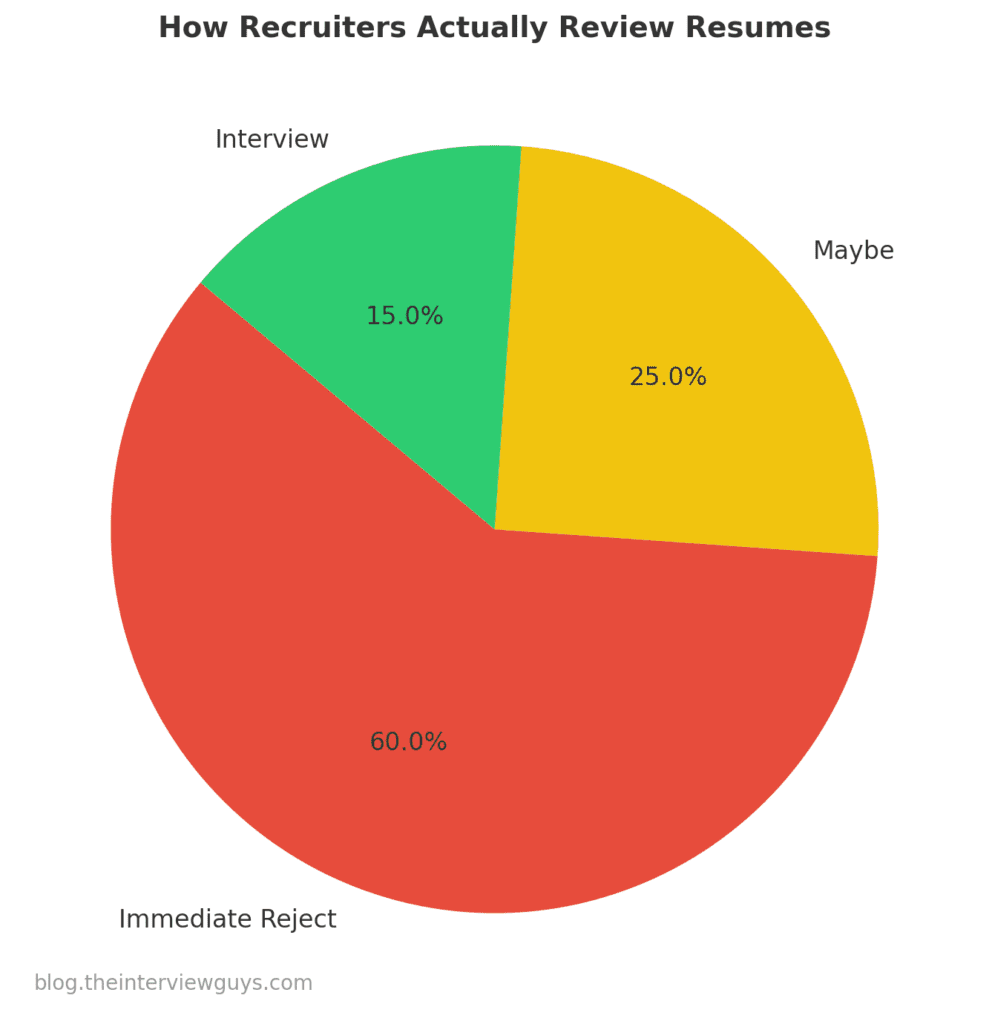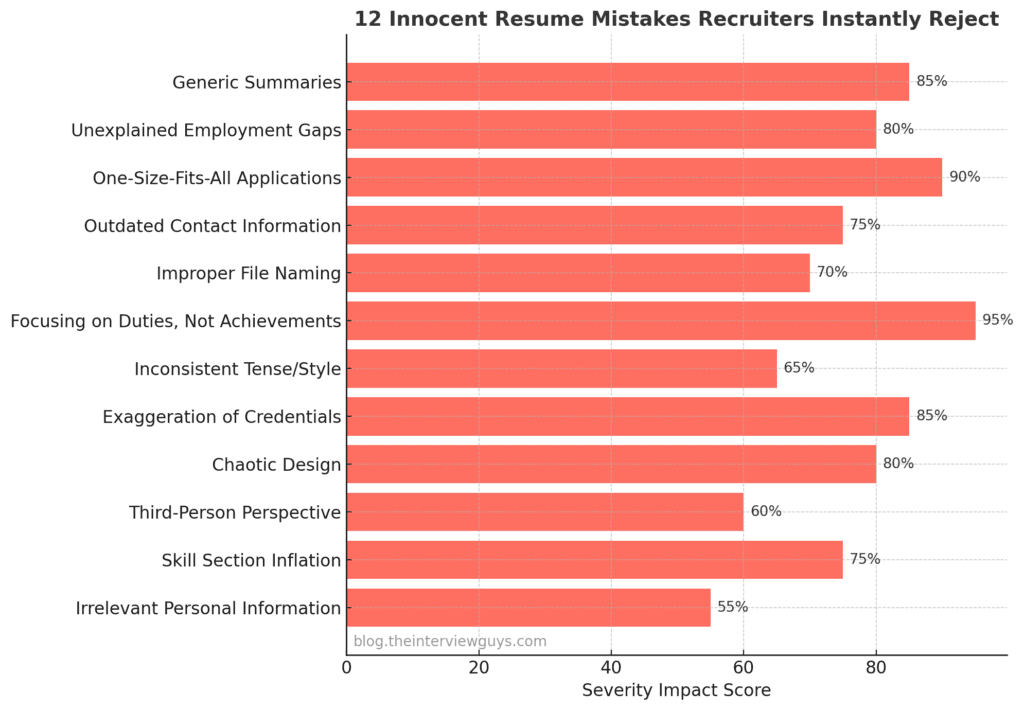Resume Red Flags: 12 Innocent Mistakes That Make Recruiters Instantly Trash Your Application
Your resume survived for just 7.4 seconds.
That’s the average time recruiters spend reviewing a resume before deciding its fate, according to eye-tracking research from Ladders. Even more sobering? Many resumes get rejected in less than 2 seconds due to immediate red flags that trigger automatic dismissal.
The cruel irony is that many career-killing resume mistakes seem completely innocent to job seekers. You might spend hours perfecting your experience section while completely overlooking issues that cause recruiters to instantly trash your application.

In today’s competitive job market, understanding these hidden landmines isn’t optional—it’s essential. As we explored in our comprehensive guide to The 6-Second Resume Test, recruiters use specific visual scanning patterns when reviewing applications. But even the most perfectly structured resume will fail if it contains these fatal flaws.
This article reveals the 12 innocent-seeming mistakes that make recruiters instantly reject resumes—and exactly how to fix them.
☑️ Key Takeaways
- Common resume red flags include unexplained gaps, job-hopping, vague language, or overly flashy formatting.
- Hiring managers look for patterns, so inconsistent timelines or missing details can raise concerns fast.
- Generic buzzwords without evidence make you sound unoriginal—back up claims with real accomplishments.
- Fix red flags by providing context, showing progression, and focusing on results, not just responsibilities.
The Psychology Behind Resume Rejections
Before diving into specific mistakes, it’s crucial to understand the psychological factors at play during resume screening:
Pattern recognition: Experienced recruiters develop mental templates of what successful candidates’ resumes look like. Deviations from these expected patterns trigger immediate suspicion.
Thin-slicing: Recruiters make rapid assessments based on minimal information—a psychological process known as thin-slicing—where small details lead to sweeping judgments about your professionalism and fit.
Risk aversion: Hiring mistakes are costly, so recruiters are primed to look for reasons to reject rather than reasons to accept. This negativity bias means a single red flag often outweighs multiple positive attributes.
These psychological factors create a harsh reality: your resume must be not just good but flawlessly aligned with recruiter expectations to survive the initial screening.

The 12 Innocent Mistakes
1. The Template Trap (Generic Professional Summaries)
“Results-oriented professional with a proven track record of success seeking to leverage my skills and experience in a challenging new role…”
If your summary could appear on thousands of other resumes, it’s actually working against you. Generic professional summaries waste prime resume real estate and signal to recruiters that you’re taking a mass-production approach to your job search.
The fix: Replace boilerplate language with a tailored, achievement-focused statement specifically connecting your most impressive accomplishments to the target role’s requirements. Keep it under 3 lines and ensure it contains at least one specific metric or achievement.
Still using an old resume template?
Hiring tools have changed — and most resumes just don’t cut it anymore. We just released a fresh set of ATS – and AI-proof resume templates designed for how hiring actually works in 2025 all for FREE.
2. The Mystery Gap (Unexplained Employment Gaps)
Employment gaps happen for legitimate reasons—health issues, family care, education, or economic downturns. However, unexplained gaps create a narrative vacuum that recruiters fill with negative assumptions.
The fix: Address gaps proactively but concisely. For longer gaps, consider a functional resume format or include constructive activities during that period (freelancing, volunteering, education). For shorter gaps, using years instead of months for employment dates can be appropriate for more experienced professionals.
3. The Copy-Paste Culprit (One-Size-Fits-All Applications)
Recruiters can spot a generic, mass-distributed resume instantly. The telltale signs include irrelevant skills, misaligned experience highlights, and language that doesn’t mirror the job posting.
The fix: Customize the top third of your resume for each significant application. This doesn’t mean rewriting entirely, but strategically adjusting your skills section, professional summary, and achievement bullets to align with each specific job description. Research shows that even moderate customization can dramatically increase response rates.
Interview Guys Tip: Create a “master resume database” in a spreadsheet with every achievement, project, and skill from your career. For each application, run the job description through a text analysis tool like Textalyser to identify recurring keywords and themes, then pull the most relevant content from your database. This data-driven approach is significantly more effective than intuition-based customization and takes half the time.
4. The Digital Disconnect (Outdated Contact Information)
Nothing says “unprofessional” like a bounced email or disconnected phone number. Beyond these obvious issues, outdated digital footprints—like abandoned LinkedIn profiles or unprofessional email addresses—can be just as damaging.
The fix: Conduct a complete contact audit before beginning your job search. Update all platforms consistently, ensure your email address follows a professional format (firstname.lastname@domain.com), and verify that all links function properly.
5. The Filename Fiasco (Improper File Naming and Formatting)
Submitting “Resume.pdf” or “Resume_final_FINAL_v2.docx” broadcasts amateur status and makes your file difficult to find in crowded applicant tracking systems.
The fix: Use a consistent naming convention: “FirstName_LastName_Position_Resume.pdf.” Always save as PDF unless specifically instructed otherwise, and verify ATS compatibility by checking that text remains selectable and properly formatted in the final document.
6. The Duty Dumper (Focusing on Duties Instead of Achievements)
One of the most pervasive resume mistakes is merely listing job responsibilities rather than concrete achievements. “Responsible for managing team projects” tells recruiters nothing about your effectiveness.
The fix: Transform each bullet point using this formula: Action + Detail + Result. For example: “Led cross-functional team of 7 to implement new CRM system, reducing customer response time by 34% and increasing retention by 12%.” Aim for at least one quantified achievement per position.
Interview Guys Tip: When you can’t directly quantify results with hard metrics, use “perception metrics” instead. For example: “Redesigned client onboarding process, resulting in 8/10 clients rating their experience as ‘excellent’ compared to 5/10 previously” or “Developed training program adopted by 3 additional departments due to its effectiveness.” These perception-based measurements are often more compelling than vague statements and show you track your impact even when direct numbers aren’t available.
7. The Tense Tension (Inconsistent Tense and Style)
Switching between past and present tense randomly or mixing first-person and third-person references creates cognitive friction for readers. This inconsistency signals carelessness that recruiters extrapolate to your potential work performance.
The fix: Use present tense for current positions and past tense for previous roles. Maintain consistent point of view throughout (typically first person implied, without using “I”). Create a style guide for your personal resume to ensure consistency across all elements.
8. The Credential Inflation (The Credibility Stretch)
Exaggerating accomplishments, inflating titles, or claiming skills you haven’t mastered might seem like a path to more interviews, but experienced recruiters have finely-tuned “embellishment detectors.”
The fix: Apply the “coffee chat test”—if you would feel uncomfortable having a conversation about any claim on your resume, revise for accuracy. Strengthen legitimate accomplishments with specific context and metrics rather than resorting to exaggeration.
9. The Visual Vertigo (Design Chaos)
Creative designs and elaborate formatting might seem distinctive, but they often create visual chaos that overwhelms recruiters and confuses ATS systems. Multiple fonts, colors, columns, and graphic elements compete for attention rather than guiding the eye.
The fix: Limit your design to a single, readable font family with no more than two sizes for hierarchy. Use white space strategically rather than graphic elements to create visual organization. If you’re in a creative field, channel design skills into a portfolio link rather than the resume itself.
Interview Guys Tip: Leverage the psychological principle of “visual chunking” by creating subtle dividing lines between resume sections with 2-3pt borders or 10-15% gray shading. This technique helps recruiters mentally organize your information without conscious effort, making your resume feel “easier” to process—a subliminal advantage when reviewers are facing decision fatigue after reviewing dozens of applications. In eye-tracking studies, resumes with well-executed visual chunking received up to 25% longer viewing times than those without.
10. The Awkward Narrator (Third-Person Perspective)
“John is a strategic marketing professional who excels at…” Writing about yourself in the third person creates psychological distance and often feels pretentious to recruiters.
The fix: Use implied first person throughout your resume, eliminating personal pronouns entirely. Begin achievement bullets with strong action verbs: “Developed marketing strategy that increased conversion by 27%” rather than “I developed” or “John developed.”
11. The Skill Stuffing (Skill Section Inflation)
Listing every software program, methodology, or technique you’ve ever encountered dilutes the impact of your genuine expertise. When everything is emphasized, nothing stands out.
The fix: Curate your skills section ruthlessly, limiting it to 12-15 of your strongest, most relevant capabilities. Organize skills into clear categories, and consider using a simple mastery indicator for technical skills rather than listing everything as equal.
12. The TMI Torpedo (Irrelevant Personal Information)
Including personal details like age, marital status, religious affiliations, or hobbies unrelated to the position can trigger unconscious bias or simply waste valuable space.
The fix: Remove all personal information not directly relevant to your professional qualifications. The rare exceptions are when personal details directly enhance your candidacy (e.g., language fluency for international roles or relevant volunteer leadership that demonstrates transferable skills).
How Recruiters Actually Review Resumes
Understanding the resume review process illuminates why these “innocent” mistakes prove so fatal. Most recruiters and hiring managers use a rapid three-pile sorting method:
Immediate reject pile: Resumes with obvious red flags or disqualifying factors (often 50-70% of applications) Maybe pile: Resumes that pass initial screening but don’t immediately stand out (20-30%) Interview pile: Standout candidates who clearly match requirements (typically only 10-20%)
The goal of fixing these mistakes is not just to avoid the reject pile but to leap directly into the interview pile. The maybe pile faces additional scrutiny only if the top candidates don’t work out.
Here’s what hiring managers report makes the difference between “maybe” and “yes”:
- Clear evidence of directly relevant achievements
- Effortless readability with perfect formatting and organization
- Immediate impression of professionalism and attention to detail
- Perfect alignment between candidate qualifications and job requirements
Implementation Guide: The Resume Rescue Plan
Follow this 15-minute audit process to identify and fix these fatal flaws:
- First impression test: Show your resume to someone for 6 seconds, then ask what they remember. If it’s not your key qualifications, redesign your visual hierarchy.
- Red flag scan: Check specifically for each of the 12 mistakes listed above.
- Customization review: Compare your resume directly against a target job description, highlighting all requirements and preferences. Your resume should explicitly address at least 80% of the must-haves.
- Technical verification: Run your resume through an ATS compatibility checker to ensure proper parsing.
- Professional language audit: Eliminate clichés, jargon, and passive voice. Every word should earn its place.
Conclusion
In today’s competitive job market, avoiding these 12 innocent but fatal resume mistakes gives you a significant advantage. Remember that your resume has one job: securing an interview opportunity. By eliminating these red flags, you dramatically improve your chances of making it past the brutal 6-second screening process and into the interview chair.
Take the time to audit your resume now, before submitting another application. The hour you spend fixing these issues could be the difference between months of job searching and landing your dream position.
Still using an old resume template?
Hiring tools have changed — and most resumes just don’t cut it anymore. We just released a fresh set of ATS – and AI-proof resume templates designed for how hiring actually works in 2025 all for FREE.

BY THE INTERVIEW GUYS (JEFF GILLIS & MIKE SIMPSON)
Mike Simpson: The authoritative voice on job interviews and careers, providing practical advice to job seekers around the world for over 12 years.
Jeff Gillis: The technical expert behind The Interview Guys, developing innovative tools and conducting deep research on hiring trends and the job market as a whole.
